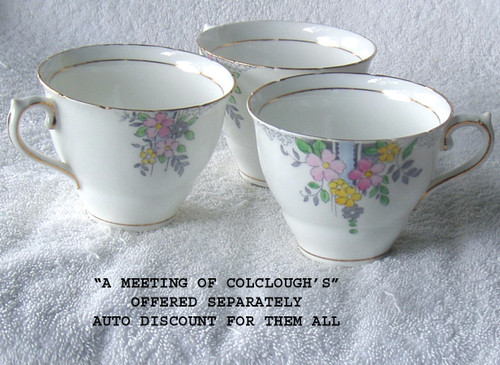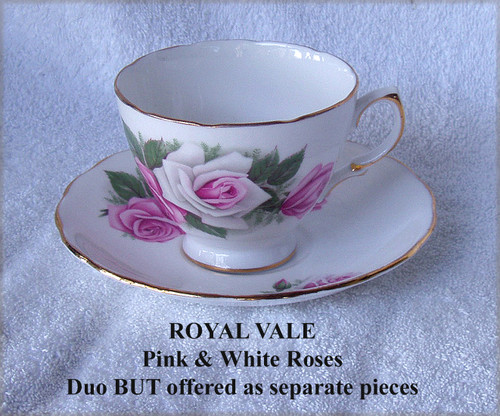Colclough China Ltd was formed in 1937 and operated their works at Longton, Stock-On-Trent. Acquired by Ridgway Potteries in the 1950's and later, in the 1960's the company became part of the Allied English Potteries group, with the latter finally becoming part of the Royal Doulton group in the 1970's
Like so many other businesses, the chinaware market was very competitive and many potteries either "disappeared" or merged together, strength in numbers.
COLCLOUGH (LONGTON) - Teacup ONLY
Trade name: Colclough
Fine bone china
Translucent china, meaning that when held to the light, you can see the shadow of your fingers through the chinaware
Transferware
Inside of the teacup is a bright White, however the outside of the body is a pale Blue. This matches the saucer which is HERE
Pattern (name unknown) comprises two sprays of Purple flowers with foliage. These look very similar to Aster's

Hand gold gilding applied to the scalloped rim, around the base and on both sides plus the back of the 'hi back' handle (similar to a Queen Anne style)
DIMENSIONS:
85mm diameter mouth x stands 75mm high
BACKSTAMP DETAILS:
Black & Pink printed backstamp design strongly suggests this teacup was produced in the period late 1960's ~ 1970's

(All text below is within an oval shape which has no border, crown etc)
BONE CHINA
A1
Colclough
MADE IN ENGLAND
There is a distinct Gold gilder's marking
COSMETIC CONDITION:
CLEAN
NO cracks
NO fleabites
NO discolouration
NO crazing
The Gold gilding is in very good condition with no signs of handling or washing wear but I have to say the gilding work is a bit 'sloppy' because the Gold around the rim "misses the mark" slightly on some of the scalloped areas and I can see two "dabs" of Gold in places they should not be. I have very carefully checked and that irregular gilding to the rim is not the result of wear n tear, just a 'lazy hand'
The handle is often the most handled area and on this teacup the gilding shows no signs of wear at all.
















